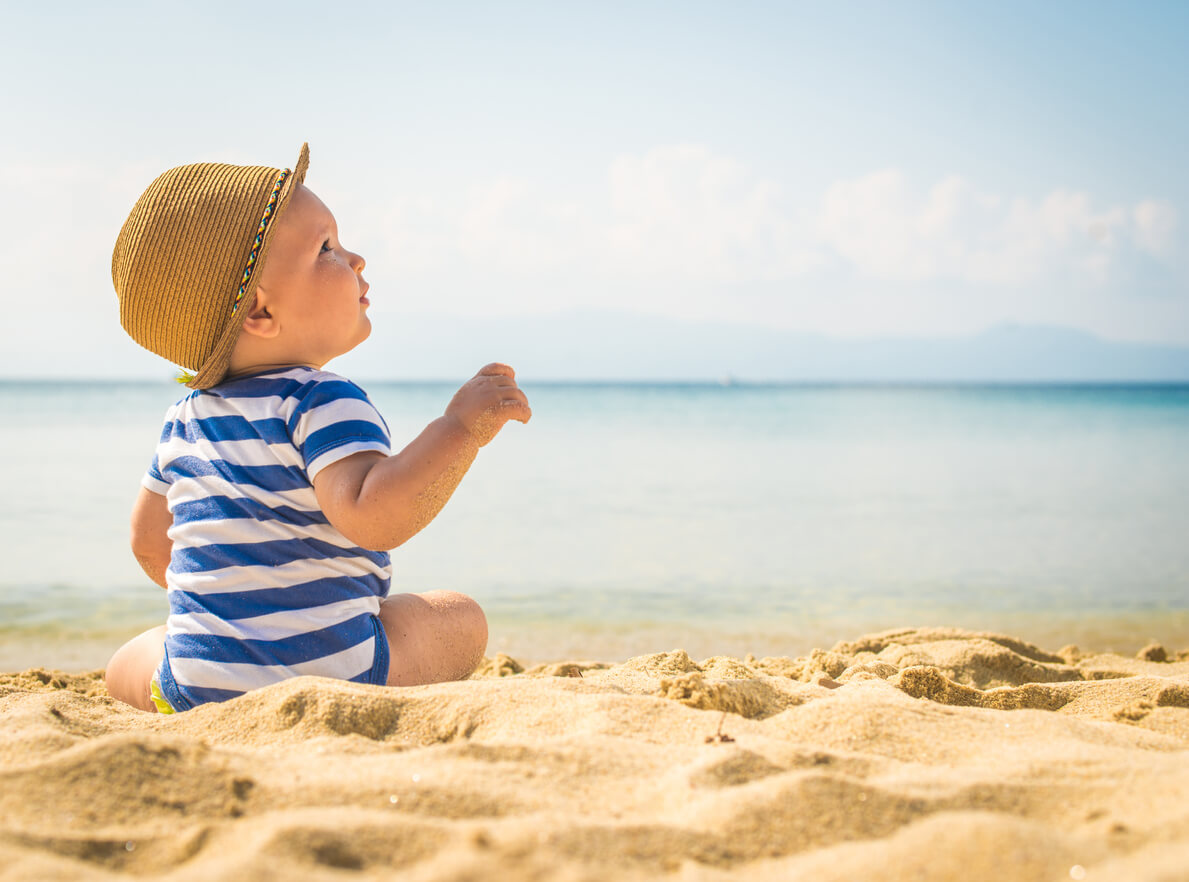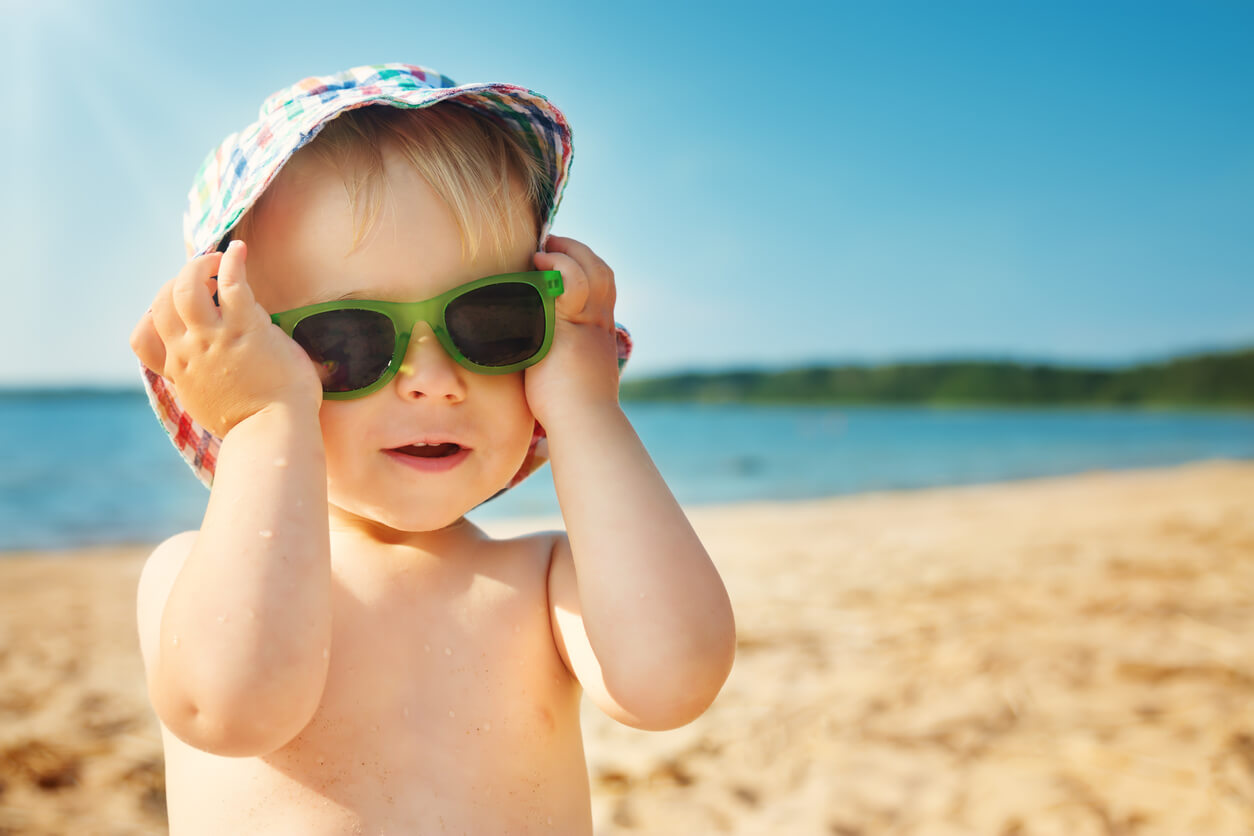Sun Abuse Damages Children's Eyes


Written and verified by the nurse Leidy Mora Molina
When we go for a walk with our little ones on sunny days, we try to protect their skin from the sun. Normally, we put some sunscreen on them to prevent sunburn, but sun damage goes beyond just the skin. In this regard, you should know that sun abuse can damage children’s eyes.
The sun’s rays can damage the surface of the eye, the cornea, and the lens, especially in children, who are more prone to suffer eye conditions due to the immaturity of their tissues. Therefore, it’s important to know the effects in order to take precautions to avoid inconveniences. Below, we’ll tell you how to choose sunglasses for your child, as well as some tips to protect the eyes from UV rays.
The effects of sun abuse on children’s eyes
Children are sensitive to sunlight, both on their skin and in their eyes. During childhood, these tissues are still developing and in the process of adapting to the environment. For this reason, we must protect them to avoid future damage.
Eyes are a sensitive and delicate tissue. Their natural filter is the crystalline lens, an ocular layer that finishes developing at approximately 12 years of age. This means that, during this time, the child’s eyes are more exposed to the effects of the sun. Likewise, the pupils of children are more dilated than those of adults and allow more light to enter.
During childhood, 75% of solar radiation is estimated to reach the retina, the innermost layer of the eyeball whose mission is to transform the light it receives into nerve impulses. However, excess radiation can cause great damage to this tissue and affect visual health.

Solar radiation
The sun emits light that reaches the earth in the form of energy known as electromagnetic radiation. Although only 5% of this ultraviolet light reaches the surface, its effects are very harmful. Ultraviolet rays are classified, according to wavelength, as UVA, UVB, and UVC. Most UVC is filtered by the atmosphere.
UVA and UVB are harmful to eye health, as they’re absorbed by the cornea and cause acute or chronic damage:
- Acute: At the moment of exposure to the sun.
- Chronic: When complications occur after a few years.
Eye problems that can appear from sun abuse
Just like our skin, the outer layers of the eyes can also burn from the effect of the sun. Moreover, the consequences are greater in children. Among the symptoms of eye damage caused by the sun are the following:
- Eye discomfort
- Pain in the eyes
- Reddening of the eyes
- Photophobia
- Dryness
In addition, solar radiation can produce the following eye injuries:
- UV keratitis or photokeratitis: This is the inflammation and irritation of the cornea due to the effects of sunlight. It occurs 6 to 8 hours after sun exposure and is treated with artificial tears and epithelizing ointment.
- Dry eye.
- Photoconjunctivitis: When the damage is in the conjunctiva.
- Retinal damage.
- Premature cataracts: Due to damage to the crystalline lens.
- Pterygium: This is a tissue that grows from the eyeball to the cornea.
These eye problems, derived from unprotected sun exposure, can cause major complications in the eyes or even loss of vision.

How to choose sunglasses for your child?
Currently, only 2% of children wear sunglasses. However, their use is strongly recommended by experts. To choose the right ones, consider the following recommendations:
- Choose lenses with UV protection. Buy them from specialized opticians that guarantee the quality of the lens.
- Confirm that the lenses have 99 and 100% protection against UVB and UVA rays.
- You shouldn’t buy toy glasses or imitations. This can cause damage to the child’s vision, in addition to not having adequate protection.
- The lenses should be large so that they protect the entire eye area. Make sure they’re of good quality, safe, and don’t break easily.
Protect children’s eyes from the sun
It’s important to take care of your child’s visual health and, apart from the use of glasses, you should also include other precautionary measures:
- Avoid exposing your child to the sun between 10 am and 2 pm. During this time, UV rays are more intense, so the child should be protected from direct sunlight.
- Use other accessories to protect the child’s skin. Large visors and hats are a good option. As children tend to reject accessories, you can avoid this by choosing a cap with a motif of their favorite cartoon characters.
- Choose comfortable glasses and accessories that allow the child to move around without the discomfort of wearing them.
- Protect your child at the beach, at the playground, and in all open places. Even if the day is cloudy, UV rays can cause damage.
If you have any doubts about how to take care of your children’s eyes and protect them from sun abuse, go to an optometrist, who will do a general vision check and guide you in finding the right lens. Above all, look for ways to protect your child’s skin and eyes on sunny days.
When we go for a walk with our little ones on sunny days, we try to protect their skin from the sun. Normally, we put some sunscreen on them to prevent sunburn, but sun damage goes beyond just the skin. In this regard, you should know that sun abuse can damage children’s eyes.
The sun’s rays can damage the surface of the eye, the cornea, and the lens, especially in children, who are more prone to suffer eye conditions due to the immaturity of their tissues. Therefore, it’s important to know the effects in order to take precautions to avoid inconveniences. Below, we’ll tell you how to choose sunglasses for your child, as well as some tips to protect the eyes from UV rays.
The effects of sun abuse on children’s eyes
Children are sensitive to sunlight, both on their skin and in their eyes. During childhood, these tissues are still developing and in the process of adapting to the environment. For this reason, we must protect them to avoid future damage.
Eyes are a sensitive and delicate tissue. Their natural filter is the crystalline lens, an ocular layer that finishes developing at approximately 12 years of age. This means that, during this time, the child’s eyes are more exposed to the effects of the sun. Likewise, the pupils of children are more dilated than those of adults and allow more light to enter.
During childhood, 75% of solar radiation is estimated to reach the retina, the innermost layer of the eyeball whose mission is to transform the light it receives into nerve impulses. However, excess radiation can cause great damage to this tissue and affect visual health.

Solar radiation
The sun emits light that reaches the earth in the form of energy known as electromagnetic radiation. Although only 5% of this ultraviolet light reaches the surface, its effects are very harmful. Ultraviolet rays are classified, according to wavelength, as UVA, UVB, and UVC. Most UVC is filtered by the atmosphere.
UVA and UVB are harmful to eye health, as they’re absorbed by the cornea and cause acute or chronic damage:
- Acute: At the moment of exposure to the sun.
- Chronic: When complications occur after a few years.
Eye problems that can appear from sun abuse
Just like our skin, the outer layers of the eyes can also burn from the effect of the sun. Moreover, the consequences are greater in children. Among the symptoms of eye damage caused by the sun are the following:
- Eye discomfort
- Pain in the eyes
- Reddening of the eyes
- Photophobia
- Dryness
In addition, solar radiation can produce the following eye injuries:
- UV keratitis or photokeratitis: This is the inflammation and irritation of the cornea due to the effects of sunlight. It occurs 6 to 8 hours after sun exposure and is treated with artificial tears and epithelizing ointment.
- Dry eye.
- Photoconjunctivitis: When the damage is in the conjunctiva.
- Retinal damage.
- Premature cataracts: Due to damage to the crystalline lens.
- Pterygium: This is a tissue that grows from the eyeball to the cornea.
These eye problems, derived from unprotected sun exposure, can cause major complications in the eyes or even loss of vision.

How to choose sunglasses for your child?
Currently, only 2% of children wear sunglasses. However, their use is strongly recommended by experts. To choose the right ones, consider the following recommendations:
- Choose lenses with UV protection. Buy them from specialized opticians that guarantee the quality of the lens.
- Confirm that the lenses have 99 and 100% protection against UVB and UVA rays.
- You shouldn’t buy toy glasses or imitations. This can cause damage to the child’s vision, in addition to not having adequate protection.
- The lenses should be large so that they protect the entire eye area. Make sure they’re of good quality, safe, and don’t break easily.
Protect children’s eyes from the sun
It’s important to take care of your child’s visual health and, apart from the use of glasses, you should also include other precautionary measures:
- Avoid exposing your child to the sun between 10 am and 2 pm. During this time, UV rays are more intense, so the child should be protected from direct sunlight.
- Use other accessories to protect the child’s skin. Large visors and hats are a good option. As children tend to reject accessories, you can avoid this by choosing a cap with a motif of their favorite cartoon characters.
- Choose comfortable glasses and accessories that allow the child to move around without the discomfort of wearing them.
- Protect your child at the beach, at the playground, and in all open places. Even if the day is cloudy, UV rays can cause damage.
If you have any doubts about how to take care of your children’s eyes and protect them from sun abuse, go to an optometrist, who will do a general vision check and guide you in finding the right lens. Above all, look for ways to protect your child’s skin and eyes on sunny days.
All cited sources were thoroughly reviewed by our team to ensure their quality, reliability, currency, and validity. The bibliography of this article was considered reliable and of academic or scientific accuracy.
- Colegio oficial de ópticos optometristas de Andalucía (2021) Efectos y lesiones de la radiación solar. Recuperado de: https://www.tuoptometrista.com/radiacion-solar/efectos-y-lesiones-de-la-radiacion-solar/
- Fernández A. (2021). Los peligros del sol en los ojos, y cómo prevenirlos. España. Caso Clínico. Revista REOP, marzo 2021, p. 9
- Garnacho, G. (2020). Efectos de la radiación solar y actualización en foto protección. Asociación española de pediatría. Vol. 92. Núm. 6. Recuperado de: https://www.analesdepediatria.org/es-efectos-radiacion-solar-actualizacion-fotoproteccion-articulo-S1695403320301661.
This text is provided for informational purposes only and does not replace consultation with a professional. If in doubt, consult your specialist.








